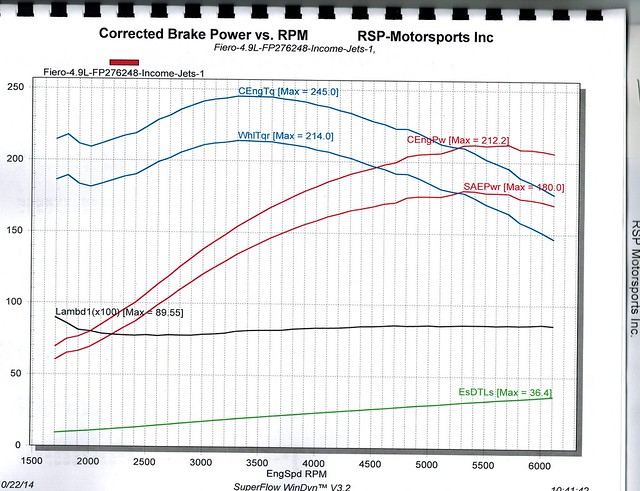
 
     |
| Drive train loss riddle. (Page 1/4) |

|
La fiera
|
AUG 26, 11:18 AM
|
|
A Fiero 2.8 V6 is rated at 140BHP and dynoed at 122WHP. What is the drive train loss if the engine power is increased to 300WHP?   
|
|

|
FieroWannaBe
|
AUG 26, 11:34 AM
|
|
If 122WHP is running correctly that is 12%.
As force and speed increases, the friction of the geartrain will increase, so that is why a percentage ratio is generaly used, although the inertial and bearing loss is a static factor of power loss.

Superflow Dyno's measure loss on the decel side of a run, so true frictional lost is not exact, its an estimate. (data is stored for inertia and friction of the dyno alone as part of the calibration).
at ~180WHP it measured a ~30hp, that is ~16%
|
|

|
FieroWannaBe
|
AUG 26, 11:54 AM
|
|
|
Also, an AWD can dyno will measure more loss than a 2WD if the front wheels and rolls are spinning also.
|
|

|
pmbrunelle
|
AUG 26, 06:35 PM
|
|
So, you dynoed a stock Fiero on a Mustang (is that what you use?) dyno, then you want to know the crank hp of your new project using a Mustang dyno result?
Or, will you have the chance to put your engine on an engine dyno, and you want to know if you'll meet the 300 whp goal?[This message has been edited by pmbrunelle (edited 08-26-2020).]
|
|

|
La fiera
|
AUG 26, 09:58 PM
|
|
| quote | Originally posted by pmbrunelle:
So, you dynoed a stock Fiero on a Mustang (is that what you use?) dyno, then you want to know the crank hp of your new project using a Mustang dyno result?
Or, will you have the chance to put your engine on an engine dyno, and you want to know if you'll meet the 300 whp goal?
|
|
I dynoed the stock 2.8 at a 122whp on the same exact Mustang dyno the 3.4 did 304whp.
I've been looking around but all the engine dynos I've found locally don't have the bolt pattern adapter for the 60*.
And if I do find one I'll have to run a mechanical distributor and a carb to make things easier.
|
|

|
pmbrunelle
|
AUG 26, 10:42 PM
|
|
How do the dyno runs work?
Does the car simply accelerate inertia of the rollers, so when a powerful car accelerates the rollers, the engine goes from idle to redline in a shorter time than a weaker car, which takes longer?
Or, is the dyno adjusting the resistance so the RPM/second increase of the powerful and weak cars is the same (less resistance for the weak car)?
|
|

|
FieroWannaBe
|
AUG 27, 08:01 AM
|
|
| quote | Originally posted by pmbrunelle:
How do the dyno runs work?
Does the car simply accelerate inertia of the rollers, so when a powerful car accelerates the rollers, the engine goes from idle to redline in a shorter time than a weaker car, which takes longer?
Or, is the dyno adjusting the resistance so the RPM/second increase of the powerful and weak cars is the same (less resistance for the weak car)? |
|
Mustang dyno's should have a absorber to control the accel rate.
|
|

|
pmbrunelle
|
AUG 27, 08:49 AM
|
|
| quote | Originally posted by FieroWannaBe:
Mustang dyno's should have a absorber to control the accel rate. |
|
Which leads to the questions:
What was the accel rate for the first run?
What was the accel rate for the second run?
|
|

|
Will
|
AUG 27, 09:40 AM
|
|
| quote | Originally posted by FieroWannaBe:
As force and speed increases, the friction of the geartrain will increase, so that is why a percentage ratio is generaly used, although the inertial and bearing loss is a static factor of power loss.
|
|
| quote | Originally posted by pmbrunelle:
Which leads to the questions:
What was the accel rate for the first run?
What was the accel rate for the second run? |
|
Like PMBrunelle is sneaking up on, the inertial component of drivetrain loss (mostly flywheel, wheels & tires as those are the large diameter components) are accelerated faster, they absorb more power. So the same driveline will have a higher absolute loss number at a faster acceleration rate.
The frictional and fluidic components of drivetrain loss (transmission friction, oil viscosity, tire deformation) will remain fairly static.
|
|

|
FieroWannaBe
|
AUG 27, 09:45 AM
|
|
| quote | Originally posted by Will:
Like PMBrunelle is sneaking up on, the inertial component of drivetrain loss (mostly flywheel, wheels & tires as those are the large diameter components) are accelerated faster, they absorb more power. So the same driveline will have a higher absolute loss number at a faster acceleration rate.
The frictional and fluidic components of drivetrain loss (transmission friction, oil viscosity, tire deformation) will remain fairly static. |
|
If the dyno is operating at a controlled accel rate, not always the case, but for a purely inertial dyno yes...
The reality is that it is generally a blend of the two.
EDIT:
Dyno Jets tend to be installed Sans eddys, so they operate on inertial load only, mustangs and superflow use eddies to add load and slow the accel rate, measuring force against a load cell, and calculating acceleration of the calibrated dyno inertia.[This message has been edited by FieroWannaBe (edited 08-27-2020).]
|
|
    
  |
|
